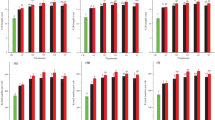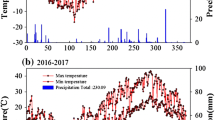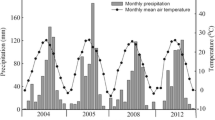Abstract
Purpose
In this study, we analyzed the effects of different maize varieties with nitrogen utilization efficiency, fertilizer type, and rate on the ammonia volatilization emission of farmland. Aimed to seek the best matching method to improve grain yield and fertilizer utilization efficiency of summer maize simultaneously.
Materials and methods
In field experiments, we choose two maize varieties with different nitrogen utilization efficiency (Zhengdan958, Z and Lainong14, L) as material. Set four different fertilizer treatments (200 kg N hm−2 inorganic fertilizer (U1), 100 kg N hm−2 inorganic fertilizer (U2), 200 kg N hm−2 organic fertilizer (M1), and 100 kg N hm−2 organic fertilizer (M2) to study their effect on NH3 emission and loss, maize grain yield, and nitrogen accumulation.
Results and discussion
Ammonia volatilization accounted for 8.61–21.68% of applied N. Under the same variety, ammonia volatilization accumulation after fertilization was as follows: U1 > U2 > M1 > M2. Ammonia volatilization rates increased first and then gradually decreased after the fertilization. The ammonia volatilization loss and cumulative loss increased due to increased nitrogen fertilizer application rate. The average nitrogen accumulation and harvest index of 200 kg N hm−2 N treatments were higher than 100 kg N hm−2 N treatments, and the difference between the inorganic fertilizer and organic fertilizer was not significant. In 2016 and 2017, the average yield of Zhengdan958 was 11,758.79 kg hm−2, which was 15.78% higher than that of Lainong14, and the difference between the two fertilizer types was not significant. The average yield of 200 kg N hm−2 N treatment was 11,959.42 kg hm−2, which was 20.13% higher than those of 100 kg N hm−2 N treatment.
Conclusions
By changing the type of fertilizer, replacing chemical fertilizers with organic fertilizer can reduce the loss of ammonia volatilization and promote the synergistic improvement to yield and resource utilization efficiency. Among them, using nitrogen-efficient varieties and using organic fertilizer instead of chemical fertilizer was beneficial to reduce the loss of ammonia volatilization, increase the accumulation of nitrogen, and promote the growth of maize to obtain high yield.





Similar content being viewed by others
References
Bruncke R, Alvo P, Schuepp P, Gordon R (1988) Effect of meteorological parameters on ammonia loss from manure in the fields. J Environ Qual 11:431–436
China Soil Science Association Agricultural Chemistry Committee (1983) Soil agricultural chemical routine analysis method. Science Press, Beijing, pp 67–68 (in Chinese)
Cui ZL, Zhang FS (2018) Pursuing sustainable productivity with millions of small holder farmers. Nature 555:363–366
Danga BO, Ouma JP, Wakindiki IC, Bar-Tal A (2009) Legume-wheat rotation effects on residual soil moisture, nitrogen and wheat yield in tropical regions. Adv Agron 101:315–349
Dolce N (1983) Involvement of super oxide anion generation in the hypersensitive response of potato tuber tissues to infection with an incompatible race of Phytophthora infestans and to the hyphal wall components. Physiol Plant Pathol 23:345–357
Gao XX, Zhang HF, Ma WQ, Wei J (2014) Effects of nitrogen application rates on yield and nitrogen utilization of summer maize. J Maize Scie 22:121–126+131 (in Chinese)
Gu LM, Liu TN, Wang JW, Liu P, Dong ST, Zhao B (2016) Lysimeter study of nitrogen losses and nitrogen use efficiency of northern Chinese wheat. Field Crops Res 188:82–95
Guo G, Wang YY, Zhang ZX, Chu WH, Pan ML (2011) A gas chromatographic method for determination of nitrous oxide in waste water treatment. J Instrum Anal 30:1050–1054
Han YG, Fan YT, Yang PL, Wang XX, Wang YJ, Tian JX, Xu L, Wang CZ (2014) Net anthropogenic nitrogen inputs (NANI) index application in Main land China. Geoderma 213:87–94
Harrison R, Webb J (2001) A review of the effect of n fertilizer type on gaseous emissions. Adv Agron 73:65–108
He Y, Yang S, Xu J, Wang Y, Peng S (2014) Ammonia volatilization losses from Paddy fields under controlled irrigation with different drainage treatments. Sci World J:417605
Huijsmans JFM, Hol JMG, Vermeulen GD (2003) Effect of application method, manure characteristics, weather and field conditions on ammonia volatilization from manure applied to arable land. Atmos Environ 37:3669–3680
Ke J, Xing X, Li G, Ding Y, Dou F, Wang S (2017) Effects of different controlled-release nitrogen fertilisers on ammonia volatilization, nitrogen use efficiency and yield of blanket-seedling machine-transplanted rice. Field Crop Res 205:147–156
Le Gouis J, Béghin D, Heumez E (2000) Genetic differences for nitrogen uptake and nitrogen utilization efficiencies in winter wheat. J Agron 12:163–173
Liu HM, Pang FJ, Lan X, Yang DL (2012) Effects of nitrogen fertilizer rate and combined application of organic manure and chemical fertilizer on soil ammonia volatilization in winter-wheat field. J Anhui Agric Sci 40(7119–7122):7249 (in Chinese)
Lu RK (2000) Soil agricultural chemical analysis method. China Agricultural Science and Technology Press, Beijing (in Chinese)
Ma BL, Wu TY, Tremblay N (2010) On-farm assessment of the amount and timing of nitrogen fertilizer on ammonia volatilization. Agron J 102:134–144
Meng QF, Cui ZL, Yang HS, Zhang FS, Chen XP (2018) Establishing high-yielding maize system for sustainable intensification in China. Adv Agron 148:85–109
Montemurro F, Fiore A, Campanelli G, Tittarelli F, Ledda L, Canali S (2013) Organic fertilization, green manure, and vetch mulch to improve organic zucchini yield and quality. Hortscience 48:1027–1033
Nakhshiniev B, Perera C, Biddinika MK, Gonzales HB, Sumida H, Yoshikawa K (2014) Reducing ammonia volatilization during composting of organic waste through addition of hydrothermally treated lignocellulose. Int Biodeterior Biodegrad 96:58–62
NBSPRC (National Bureau of Statistics of the People’s Republic of China) (2017) China statistical yearbook. China Statistics Press (in Chinese)
Olesen JE, Rubæk GH, Heidmann T (2004) Effect of climate change on greenhouse gas emissions from arable crop rotations. Nutr Cycl Agroecosyst 70:147–160
Qu JW, Gao JL, Wang ZG, Yu XF, Hu SP, Sun JY (2016) Effect of nitrogen rate on temporal and spatial distribution of roots and nitrogen uptake of maize with genotypes of high or low nitrogen efficiency. J Plant Nutr Fertil 22:1212–1221 (in Chinese)
Rochette P, Angers DA, Chantigny MH, Gasser MO, Macdonald JD, Pelster DE (2013) Ammonia volatilization and nitrogen retention: how deep to incorporate urea? J Environ Qual 42:1635–1642
Shan LN, He YF, Chen J, Huang Q, Wang HC (2015) Ammonia volatilization from a Chinese cabbage field under different nitrogen treatments in the Taihu lake basin, China. J Environ Sci 38:14–23
Sharma P, Laor Y, Raviv M, Medina S, Saadi I, Krasnovsky A (2017) Green manure as part of organic management cycle: effects on changes in organic matter characteristics across the soil profile. Geoderma 305:197–207
Sinebo W, Gretzmacher R, Edelbauer A (2004) Genotypic variation for nitrogen use efficiency in Ethiopian barley. Field Crop Res 85:43–60
Søgaard HT, Sommer SG, Hutchings NJ, Huijsmans JFM, Bussink DW, Nicholson F (2002) Ammonia volatilization from field-applied animal slurry—the alfam model. Atmos Environ 36:3309–3319
Song YS (2003) Summary of research on ammonia volatilization in paddy soil
Thomas RL, Sheard RW, Moyer JR (1967) Comparison of conventional and automated procedures for nitrogen, phosphorus, and potassium analysis of plant material using a single digestion. Agron J 59: 240-243
Wan XJ, Wu W, Li C, Liu Y, Wen X, Liao Y (2016) Soil ammonia volatilization following urea application suppresses root hair formation and reduces seed germination in six wheat varieties. Environ Exp Bot 132:130–139
Wang ZH, Liu XJ, Ju XT, Zhang FS, Malhi SS (2004) Ammonia volatilization loss from surface-broadcast urea: comparison of vented- and closed-chamber methods and loss in winter wheat–summer maize rotation in North China plain. Commun Soil Sci Plant Anal 35:2917–2939
Wang JC, Xue C, Song Y, Wang L, Huang QW, Shen QR (2016) Wheat and rice growth stages and fertilization regimes alter soil bacterial community structure, but not diversity. Front Microbiol 7:1207
Xu JZ, Liao LX, Tan JY, Shao XH (2013) Ammonia volatilization in gemmiparous and early seedling stages from direct seeding rice fields with different nitrogen management strategies: a pots experiment. Soil Tillage Res 126:169–176
Yan J, Yao AH (2003) Influence of soil properties on N2O emissions from farmland. Climatic Environ Res 8:457–466
Yang QL, Liu P, Dong ST, Zhang JW, Zhao B, Li RF, Ren H, Ren H, Han XF (2018) Effects of combined application of manure and chemical fertilizers on loss of gaseous nitrogen and yield of summer maize. Sci Agric Sin 51:2476–2488 (in Chinese)
Zaman M, Saggar S, Blennerhassett JD (2009) Effect of urease and nitrification inhibitors on N transformation, gaseous emissions of ammonia and nitrous oxide, pasture yield and N uptake in grazed pasture system. Soil Biol Biochem 41:1270–1280
Zhang YT, Wang HY, Liu S, Lei QL, Liu J, He JQ, Zhai LM, Ren TZ, Liu HB (2015) Identifying critical nitrogen application rate for maize yield and nitrate leaching in a Haplic Luvisol soil using the DNDC model. Sci Total Environ 514:388–398
Zheng FX, Dong ST, Liu P, Zhang JW, Zhao B (2017) Effects of combined application of manure and chemical fertilizers on ammonia volatilization loss and yield of winter wheat. J Plant Nutr Fertil 23:567–577 (in Chinese)
Funding
This work was supported by grants from the National Key Research and Development Program of China (2016YFD0300106), the National Key Technology Support Program of China (2013BAD07B06-2), the National Natural Science Foundation of China (31371576), and the Shandong Modern Agricultural Technology & Industry System (SDAIT-02-08).
Author information
Authors and Affiliations
Corresponding author
Additional information
Responsible editor: Yongfu Li
Publisher’s note
Springer Nature remains neutral with regard to jurisdictional claims in published maps and institutional affiliations.
Rights and permissions
About this article
Cite this article
Yang, Q., Liu, P., Dong, S. et al. Effects of fertilizer type and rate on summer maize grain yield and ammonia volatilization loss in northern China. J Soils Sediments 19, 2200–2211 (2019). https://doi.org/10.1007/s11368-019-02254-1
Received:
Accepted:
Published:
Issue Date:
DOI: https://doi.org/10.1007/s11368-019-02254-1




